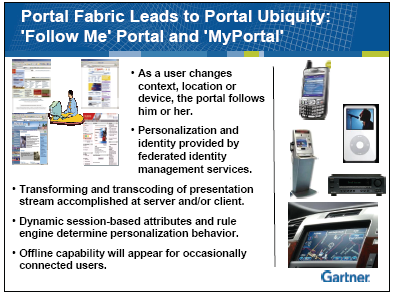Gartner: The future of portals is mashups, SOA, more aggregation

Judging from a presentation by Gartner analyst David Gootzit, it's clear we're portaled out. The solution: Aggregation.
This argument is a bit to digest given portals aggregate information in the first place. In effect, the future is aggregation of the aggregators via mashups and shared APIs across consumer and enterprise portals. Gootzit reckons that most of the mashup experiments in the enterprise will come through portals.
Why will this happen? It has to--you can only go to so many portals. Gootzit's presentation on the future of portals at the Gartner Symposium/ITxpo revealed a few interesting nuggets in the back and forth with the audience. Two factoids:
- The average enterprise had three portals;
- Including visits to banking applications and consumer portals there's about 6 portal visits per user. The future of portals is aggregation.
Enterprise portals will begin aggregating various portals internally in mashups. Meanwhile, enterprises may start providing APIs to plug services into Google and other consumer portals. Portals will be lumped into two categories: Aggregators and aggregatees.
For instance, an enterprise portal, say a utility company, may find it beneficial to be lumped into another portal. An enterprise may even provide an API so customers and partners can get to their information through Google.
These portal rollups will be wrapped up into a concept called myPortal.
Among other trends that may surface by 2009:

The myPortal will become the aggregated layer that will grab local data, corporate data and the Web. These portals will surface services to customers and partners no matter what they choose as an uber portal and what device they use.
75 percent of organizations will obsess on Web 2.0 technologies to enhance portals through 2009 without consulting or training users. Will your users know how to use mashups? "A lot of enterprises will miss this," says Gootzit.
Of course, there are a few items that may derail this portal mashup-a-thon. For starters, standards are an issue.
To make all this portal aggregation happen all you need is standards for portlets, user profiles, directories, security and meta data. "You've got time to implement this strategy," says Gootzit.
And then there's security. Lumping your corporate data with a public API could be a major security risk. Gootzit played down this concern. "Security is also about letting the good guys in," he says.